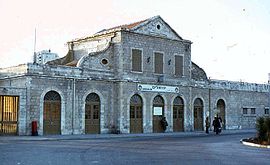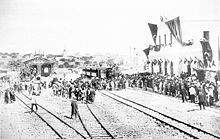- Jerusalem Railway Station
-
- For other stations in Jerusalem, see Jerusalem Malha Railway Station and Jerusalem Binyanei HaUma Railway Station.
Jerusalem Railway Station
תחנת הרכבת ירושלים
أورشليم القدس
Jerusalem Railway Station in 1978Station statistics Address David Remez Street, Jerusalem Lines Tel Aviv – Jerusalem Platforms 2 Tracks 4 Other information Opened 26 September 1892 Closed 15 August 1998 The Jerusalem Railway Station (Hebrew: תחנת הרכבת ירושלים, Tahanat HaRakevet Yerushalayim) is a former railway station located in the area between Hebron Road and Bethlehem Road, near the German Colony of Jerusalem, Israel. It was part of the Jaffa–Jerusalem railway until its closure in 1998. The station today is also known as the Khan station for the old caravanserai building located across the road from its site (now The Jerusalem khan Theater).
The station was opened in 1892 as a terminus of the Jaffa–Jerusalem line, at the 86.6 kilometer mark, at an elevation of 747 meters.[1] In 1998 the railway line to Jerusalem was closed and the station has been decaying since. It was not included in the restoration of the Tel Aviv – Jerusalem line, completed in 2005.[2] Plans exist to renovate it as an entertainment venue, similarly to the Jaffa Railway Station.
 The Jerusalem Railway Station inauguration ceremony, 1892. The windmill built by Sir Moses Montefiore in seen in the background
The Jerusalem Railway Station inauguration ceremony, 1892. The windmill built by Sir Moses Montefiore in seen in the background
Contents
History
Main article: Jaffa–Jerusalem railwayThe idea to build a railway linking the coast with the Jerusalem was first raised in the middle of the 19th century by Dr. Conrad Schick, Moses Montefiore and others. The franchise for laying the railway was obtained from the Ottoman government by Joseph Navon, but due to financial difficulties, he had to sell the franchise to a French company which was set up to build the line – Société du Chemin de Fer Ottoman de Jaffa à Jérusalem et Prolongements.[3]
In 1892, construction of the line from Jaffa to Jerusalem was finally completed: "paved route of the trail donkeys", an ancient way of rising to Jerusalem passes through Nahal Sorek and Ghost Valley. The station was inaugurated on 26 September 1892 in the presence of the city's dignitaries, Jews and Arabs. Among those present at the ceremony was Eliezer Ben Yehuda, the reviver of the Hebrew language, which gave the train the literal name of – horse of the steel in Hebrew as the word Rakevet had not yet been created.[4]
The station operated almost continuously until 1948, when traffic stopped on the Jaffa–Jerusalem line due to the 1948 Arab–Israeli War. At the end of the war a section of the track near Beit Safafa, an Arab neighborhood in southeastern Jerusalem, remained under the control of the Jordanian Arab Legion. Following the Rhodes armistice agreement, it was agreed that Jordan will hand the control of this section of the track to Israel, in order to enable Israel Railways to restart the service to Jerusalem.[4]
As a result, between 1948 to 1967 the Beit Safafa neighborhood was divided; the area south of the railway line was part of the Jordanian controlled West Bank and the railway line itself and small area to the North part of the Israeli controlled section of Jerusalem. The service on the line resumed on August 7, 1949.[4]
In 1959 the railway tracks to Jerusalem underwent extensive renovations, but over time, the number of passengers using the line decreased. For the majority of the years until the line was finally closed, there was only once or twice daily service to Tel Aviv South Railway Station (now also closed) and / or Haifa Central Railway Station. During the 1990s, due to the poor level of railway tracks maintenance, there were many minor derailments[5]; therefore it was decided to close the section of the Jaffa–Jerusalem railway line from Beit Shemesh Railway Station along Nahal Sorek to Jerusalem. On 14 August 1998 the last train service left the station, and on 15 August 1998 the station was officially closed.
The station building
The station building is a symmetrical structure containing the station offices, ticket hall and a Concourse. The original building (before later modifications) was identical to the Ramla Railway Station and Jaffa Railway Station buildings, which were all built at the same time.[4]
The triangular arches on the roof of the first floor, on both sides of the ticket hall, were built in early 1920s by the British-run Palestine Railway, who managed the railway during the British Mandate of Palestine. The building underwent many renovations over the years, but its basic shape has not changed since 1920.[4]
The station today
Today, the station is abandoned and suffering from neglect and vandalism. The area where the station is located is of prime real estate potential. One of the plans of the Jerusalem Development Authority is to build a new neighborhood on the land surrounding the station. The plan also includes moving the station building about 20 meters to make room for a new road, however conservation officials have expressed concern that moving the station would cause the destruction of the entire structure, this despite being one of 110 buildings selected for preservation in Jerusalem.
In recent years the area around the station has been used during cultural events; such as: the Jerusalem Film Festival, Jerusalem Jazz Festival and Israel Festival.[6]
See also
- Ramla Railway Station
- Jaffa Railway Station
References
- ^ Travis, Anthony S. (2009). On Chariots with Horses of Fire and Iron. Jerusalem, Israel: Magnes Press. p. 74. ISBN 978-965-91147-0-2.
- ^ Ehrlich, Sybil, "New train service proves a hit in Jerusalem and Ashkelon. Capital's rail link renewed after almost seven years", Jerusalem Post Article date: Apr 11, 2005, http://pqasb.pqarchiver.com/jpost/access/820194691.html?dids=820194691:820194691&FMT=ABS&FMTS=ABS:FT&date=Apr+11%2C+2005&author=SYBIL+ERLICH&pub=Jerusalem+Post&edition=&startpage=04&desc=New+train+service+proves+a+hit+in+Jerusalem+and+Ashkelon.+Capital%27s+rail+link+renewed+after+almost+seven+years, retrieved 2009-11-06
- ^ Glass, Yosef, "Yosef Navon Bey and his involvement in late 19th century Palestine's development", Cathedra (in Hebrew). 62 (1992)
- ^ a b c d e Wallach, Yair, "Nostalgia and Promise in Jerusalem's Derelict Ottoman Railway Station", The Jerusalem Quarterly Summer 2009 (38), http://www.jerusalemquarterly.org/ViewArticle.aspx?id=306, retrieved 2009-11-06
- ^ Ehrlich, Sybil, "No Tel Aviv-Haifa train service today", Jerusalem Post Article date: September 1, 1995, http://www.highbeam.com/doc/1P1-5994416.html, retrieved 2009-11-06
- ^ "Moonlight Cinema at the Old Train Station", The Jerusalemite – the Jerusalem Culture Guide – July 14, 2008, http://www.jerusalemite.net/blog/2565/moonlight-cinema-at-the-old-train-station, retrieved 2009-11-06
Coordinates: 31°46′0.66″N 35°13′28.96″E / 31.76685°N 35.2247111°E
Categories:- Railway stations in Israel
- Railway stations opened in 1892
Wikimedia Foundation. 2010.


